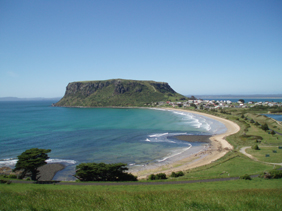Stanley is established about 20 km from Smithton, 100 km from Wynyard, about 230 km from Launceston and 130 km from Devonport. It is located in the heart of the major tourist area.
The beautiful historic village of Stanley lies beneath the ancient volcano known locally as the 'The Nut`. It is a large flat-topped circular headland that is more than 150 m high. You can stroll to the summit or take the local chairlift and glimpse stunning scenery of the surrounding coastline. Stanley has kept the feeling of an historic dock and harbour with a tiny angling fleet still utilising it for protection and processing crayfish and diverse localized fish species. The village features a charming marine aquarium, numerous historic cabins and an array of art galleries and antique shops. In the wharf locality there numerous stone historic structures, some of which have been altered to provide tourist amenities.
There is charming blue-stone accommodation in renovated warehouses on the shoreline. The Highfield Historic Site, established beside Stanley dates from 1837, is was where the renowned Dieman's Land Company operated.
The location encompasses horse stables, a homestead, barns and diverse workers` cabins, all in a charming setting. Tours of the historic location are run every day and there are ghost trips after dark, if you dare. The charming set of cabins underneath The Nut presents a exclusive picture-post card setting to this charming shoreline town.
There are numerous fine art and home wares galleries, a tavern and food outlets in Stanley, and numerous intriguing tourist attractions. The local pub serves superb counter meals. South of Stanley are the Mawbanna and Dip Falls and numerous other picturesque attractions in the natural reserves. The village is about 100 km from Wynyard, and has won the Premier Tourist Town in Tasmania award many more times than any other village in the past 10 years.
There are many excellent places to stay on the water front. There is a wide range of things to do and see in Stanley. Entertainment buffs will find lots of options in Devonport and Wynyard. There is a caravan reserve nearby. There are also some excellent wineries in the area.









